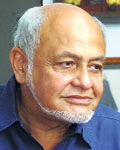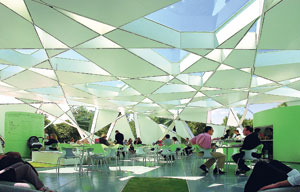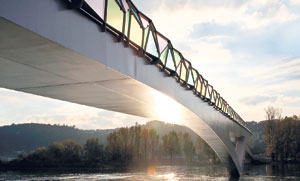When Charles Jencks, considered the godfather of the postmodern movement in architecture, compiled a list of the world’s ten most influential modern buildings for the BBC in the late 90’s, one man’s name figured prominently- seven times to be exact. Cecil Balmond, the Sri Lankan born structural engineer though not enjoying the widespread acclaim that has been accorded to his architect peers, nevertheless has been a dominant influence in contemporary architecture.
In Colombo this week, to deliver the annual Geoffrey Bawa lecture at Ananda College’s Kularatne Hall, Balmond revealed just why he is considered a revolutionary force as he spoke of the many iconic buildings around the world that carry his signature.
 |
| Cecil Balmond |
The work he unveiled though perhaps unfamiliar to a local audience was awe-inspiring, each redefining architectural elements and extending boundaries of space. Buildings like the Serpentine Pavilion in the UK, the Coimbra footbridge in Portugal, the CCTV tower in Beijing, the Carlsberg Brewery in Southampton, the Victoria and Albert Museum Spiral and so many more, underscoring his immense prowess as engineer, architect, author and artist.
At the Lunuganga Trust offices the next morning in a house that Bawa built, his keen eye noting with appreciation the finer details of design, he is on a different tack - the little known but strong connection he has with the land of his birth.
That pull is stronger now, the conviction that the time is right to give something back. Already brewing in his mind is an architecture school in Kalpitiya where he bought some land just so his children would have a place here. “I built three cabanas. There’s also a big back plot where I wanted to make a craft school for the village children. It hit me - why don’t I have an architectural school?”
What he envisages is that he will come down with some of his architecture friends, perhaps some of his best students and for two weeks each year conduct a workshop - a meeting of East and West, “looking at monsoon architectural forms -two days of Sri Lanka - Sigiriya, Anuradhapura- the Sri Lankan legacy and potentialities and juxtapose that with intensive modern technique, scripting, computer programming,” he says, now torn between the idea of building an interesting structure to house the school or plunging in straight off even in a rough hut.
Balmond has lived away for almost five decades but the distinct pride in his heritage has never left him. He still refers to himself as a Sri Lankan Burgher, though now a naturalised British citizen. His father H.J. Balmond was a well-known figure in academe, being Registrar of the University of Ceylon in those days when the post was held in high esteem-- “he signed all the degree certificates”. The young Cecil remembers his boyhood in Borella and early years at Royal College before his father moved to the University of Peradeniya and he to the Trinity College boarding.
 |
| Adventurous design: The Serpentine Gallery Pavilion in London |
 |
| Ephemeral design: Balmond’s foot bridge in Coimbra, Portugal |
“Being at the University I was very privileged,” he says, recalling Lee Kuan Yew visiting and Chou en-Lai. It was not only heads of state - “When they filmed the Bridge on the River Kwai, our house was central. I remember David Lean and William Holden coming there. So I grew up with this feeling that Sri Lanka was the centre of the world.”
There were all the carefree joys of boyhood, long treks in the forests of Hantane, Udawattekelle and quieter moments, sitting on the low side walls of the Trinity chapel taking in David Paynter’s hauntingly beautiful murals; he muses that this may have been where his artistic inclinations were shaped.
He remembers too winning the Shakespeare prize at Trinity, to prove a point to his father who had said that Science students couldn’t do the Bard. But for a student who excelled in mathematics, the Science stream was the only option leading to either medicine or engineering and he says ruefully that the choice had to be made as young as age 13. He remembers a vice principal’s prophetic words, ‘Balmond, you’re making a big mistake... you are meant for the arts.”
Just before he left school came another pointer of where his true calling lay- he won an Ideal Home competition that he had entered just for the sake of winning the prize money to buy a motorbike that his mother was set against. Competitors had to design an ideal home and even furniture for a budget and though the details are hazy now, it transpires Bawa and his partner Ulrik Plesner had a hand in the competition.
Not long after, having sailed through the H.Sc exam, he found himself in the Peradeniya gym taking the entrance test for University; looking round at the thousands of students there, thinking that he would never make it.
But make it he did to study civil engineering at Colombo University until his father was invited to create and run Nigeria’s new universities. Somewhat adrift with his family gone, he decided to leave too, much to his father’s disapproval and try his luck elsewhere. He ended up in England on the advice of his father’s friend, Sir Ivor Jennings, former Chancellor of the Peradeniya University. “My father wrote to him asking what I should do and Jennings said I should come to England and to Cambridge.” He went to the first university that accepted him- Southampton.
Then followed in his early 20’s, rejoining his father in Africa, a time for music – a love that still absorbs him. His mother Ruth Herft had been a star tennis player and classical pianist, (his father too), though he says with some regret that it was a mistake trying to learn from her. Raps on the knuckles with a ruler were the order of the day for any lapses. “My mother was a natural talent. At parties as the band left at 1 in the morning, she would start playing,” he recalls. His father was the intellectual, who took him to the library, gave him authors like Aldous Huxley to read when he was barely into his teens and whose name on the prize lists of Trinity’s halls placed a somewhat unfair weight on his son.
He gave up the piano but took up the guitar and played with a band, trained Nigerian choirs and even had his own TV show. Here too the designer in him came through when dissatisfied with the backdrop and the lighting he did his own.
When the Biafran war broke out, Balmond returned to UK and went on to do the first of two advanced degrees in engineering at Imperial College. Joining the already renowned engineering firm of Ove Arup and Partners, London then engaged in constructing the Sydney Opera House, he began a long and fulfilling career with them.
The recognition of his skills by his peers was quite gratifying for a raw young man (this he attributes readily to the quality of his Ceylon education) but these were tough times to be a foreigner in Britain. Maverick politician Enoch Powell was whipping up anti-immigrant fervour and it had an ugly face. Balmond vividly remembers being hit by milk bottles and having old ladies move away when he took a seat next to them in the bus. But he was never one to look back or regret decisions taken- he stayed on.
He felt at home at Arup and realized quickly that he wanted to do building and so went off to do advanced structures exams at Imperial. “I came back and started experimenting, moving grids around and soon realized that what I was doing was really about architecture. It was structure, but I was entering another field of awareness of building form, the spatial element of this in relation to the three-dimensionality of what a point in space, a line in space does.”
There was a gulf he realized between architects and engineers and his advice to the latter is pointed. “Talk their language,” he says bluntly. “I suddenly realized that architects saw engineers as the enemies of promise. They wouldn’t even meet them halfway, but fortunately at Arup’s they did.
Collaboration is a difficult art, he remarks - it’s a two-way thing, like a good accompanist with a singer. It’s fine if it works. But he says wryly, most often engineers don’t have a voice, architects are the dominant force.
By his early 30s, he was pushing the boundaries. “Whatever the architectural hypothesis that I was working with, I would stretch the hypothesis. If an architect came to me saying ‘I want to do this’, I would also show him you could do that and that.”
“Over the years working in engineering and collaborating with architects, all these things were encouraging me to practise architecture. It became a sort of fusion. I read more, studied more.” He was fortunate that it came to him naturally, he says, the mathematical sense and his background in music, he was discovering Bach by then and that was to be a huge influence on him. It’s never one thing, he muses, citing music, mathematics, all the forces that inspire him. “As a designer your obligation is to widen the influences on you. Architecture like a lot of design art is a synthesis. It’s a building science and a building craft. I found architecture fascinating because of its breadth between craft and theory- one was high blown visionary stuff and one was down to the ground, how the toilet door opens- you have to do both.
“I learnt from my engineering training that if you fly a kite you have to keep your feet on the ground, the kite can’t pull you up. You need an absolute grounding so that you can fly the kites.”
“Years ago I thought I should become a philosopher of design,” he says. “My interest is in theory and philosophy of structure. There is something about the conceptual models of decision taking, how you think – a philosophy of thought. Another higher level of understanding.”
He was fortunate he says to have worked with some of the stellar names of the day, the formidable Jim Stirling, Japanese architect Toyo Ito, German Daniel Liebeskind and Dutch architect Rem Koolhaus- the partnership with the latter stretching some 15-18 years, building some of the world’s most celebrated modern landmarks.
How did the architects react when he ventured into their turf? He is not inclined to say too much. “If I was enhancing their thought processes no one would say no.” With Rem Koolhaas, of similar age there was an instant affinity. “It’s an intimacy of thought. It’s almost telepathic,” is how he describes their rapport. “We work separately but the moment we get together something happens, the design jumps a whole quantum.
“In the world of architectural history, our collaboration from 1988- 2002, the first ten years were very successful. We took on competition after competition and won so many of them.” He recalls one heady summer when they entered five competitions and won three of them.
In 2000, by then Deputy Chairman of Arup, a post he still holds, he formed the Advanced Geometry Unit comprising an elite eclectic group, a quantum physicist, computer scientists, virtual theorists and that rare breed- architects cum engineers to do research-based work- influencing architecture in a new way.
Of the many structures he’s seen rise, he confesses a particular fondness for the Serpentine Gallery pavilion in London which he built with Toyo Ito in 2002.
Now in the hands of a new owner it is to be reinvented in the south of France as a restaurant, and Balmond is happy to oversee its new incarnation.
In 2005, the RIBA (Royal Institute of British Architects) inaugurated the Charles Jencks ‘Theory in Practice’ award and chose Balmond as the first winner. It was a proud moment for him, a vindication of sorts for what he had set out to be. “I had gone into territories that were not my terrain but I had never accepted any boundaries and it was a nice reward that the profession recognized that,” he says. “To put theory into practice is not easy- it’s my engineering training that has given me the pragmatic conceptual rigours to do it.”
While the projects took him around the world, he taught too at the Yale School of Architecture, at Harvard and now at the University of Pennsylvania as Cret Professor at the School of Architecture. He has left his imprint on the campus in the post-modernist Philadelphia Weave Bridge, another project he is particularly proud of.
Writing has become important too, he ventures, to put down all those thought processes, though he is the first to admit to being very slow at getting the books out. His first ‘No 9’ –exploring numbers, which he suggests he’d like to see printed in Sinhala was published in 1998. Then came ‘Informal’ which won him the Banister Fletcher prize for best book of the year for architecture in 2002 and there’s a new one due next year.
Now in his sixties Balmond is still driven, searching for more heights to conquer. Asked if he’d like to work in Sri Lanka, his response is immediate. As he sees it, there are three scales to it. “Firstly, I’d like to show a monumentality to a Sri Lankan piece of work- make it a global landmark building– so that everyone will wake up and say, ‘oh Sri Lanka has that’. Lend an iconic power to form, so to speak.” The second project he fancies would be a factory and the third perhaps a domestic villa “my way - taking in Sri Lankan elements of rain, air”, he says.
“Ten years ago, Senaka (Bandaranayake) wanted me to design rope bridges in Sigiriya. I’d love to do stuff like that.”
It is a leitmotif of this interview- the connection with the land of his birth, to which his son John has now returned. For Balmond’s recent exhibition in January 2010 in Tokyo, he drew from Lanka’s storied past. “I had this huge mural of Sigiriya. I contrasted it with Ayers Rock. So one whole area had the red of Ayers Rock and the black of Sigiriya and then the sketches I put on the rock. Everybody loved that area of the show. Sigiriya is not known as one of the wonders of the world.” It should be, he feels.
“I grew up when Sri Lanka was looked up to in the South East Asia paradigm,” he stresses, “when I was proud to go out as a Sri Lankan.” Sri Lanka must go outward, he insists. “I’m saying I want Sri Lankans to go out there. Just have your mindset out there. You can then influence from Sri Lanka. With my heritage I went out into the Western world and rose to the top.” The unspoken words are that others can too.
As for him there's still major work ahead. Come 2012 when London hosts the Olympic Games, a massive spiralling sculpture, 22 m higher than the Statue of Liberty will rise against the skyline, the city's monument to the Games. The brains behind it - Anish Kapoor of Turner Prize fame and Balmond himself. |




